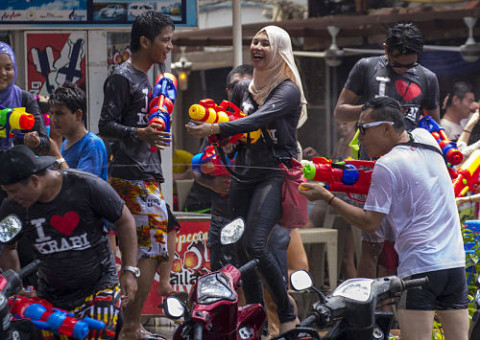10 Facts you Need to Know about Songkran!
Visiting Thailand? Then make sure your travels coincide with the three-day Thai new year celebration, known as ‘Songkran’.
Having travelled extensively across South East Asia, Songkran, was by far, the most beautiful festival that I had the fortune to take part in.
Described by many as ‘wild and wet’, I couldn’t agree more.
It’s also a little crazy but if you want to experience Thai people and their culture close-up then taking part is a must.
Here are some facts about Songkran to help you understand the most loved of Thailand’s festivals...
1. Songkran comes from the Sanskrit word samkranti which essentially means to pass, transform or change. Spanning back into antiquity, Songkran was the official and ancient new year of Thailand. However, in 1940, the New Year was changed to January 1st and Songkran instead became considered as an official holiday.
2. Songkran coincides with the period of time when the sun enters Aries which generally happens around the middle of April. However, the Thai government have fixed the date to the 13th April for ease of planning and extended the holiday to create a three-day celebration.
3. When the sun enters Aries, it also becomes equidistant to the earth creating a situation in which the length of the day and night become equally split. This has become known in Thai history and culture as the ‘supreme cycle’.
4. The act of pouring water and sprinkling it on others symbolises the concept of ‘washing away the past’. However, over time this has transformed into a full-blown firing of water at friends and complete strangers with water guns (including high-pressure ones), hoses, pots, pans and buckets. The event can become so boisterous that busy roads are closed; transforming them into water parties!
5. Day one of Songkran focuses on renewal and saying goodbye to the old by respectfully cleaning Buddha statues, spring cleaning the home, getting rid of unwanted possessions and buying new clothes. Thais also come together to celebrate communal processions of Buddha statues and take part in the most boisterous of water festivities. This is the day when the water guns make their appearances!
6. Day two focuses on carrying out good deeds, avoiding bad words, smiling, giving offerings to monks and attending temples to build sand chedis, which are essentially sand temples as opposed to sandcastles!
7. On the final day, Thais continue to carry out good deeds such as giving offerings to monks and sprinkling holy water on Buddha statues. Families also come together, with great emphasis being placed on visiting older family members to seek their blessings.
8. White talcum powder also plays a role and is sprinkled on people as a way of providing protection from evil spirits and preventing bad or unlucky events from taking place.
9. Mr and Miss Songkran pageants are an important part of Thai celebrations with men and women dressing in beautiful traditional clothing, which is representative of their region and culture. Unlike Western pageants, swimwear is not part of the event!
10. Festivals with similar roots and forms are also celebrated across other parts of South East Asia, such as in Cambodia, Myanmar and Laos. For example, in China, the Dai ethnic minority celebrate the event by shopping at market stalls along the Mekong river, eating street food and taking part in events such as dragon boat racing and floating lantern displays. The water event is reserved until the third day when people drench each other water!
Want to learn more about Thai culture? Check out our Online Thailand Cultural Awareness Course.
Photo by helmi099 on Flickr (CC BY-SA 2.0)
By accepting you will be accessing a service provided by a third-party external to https://www.commisceo-global.com/

 +44 0330 027 0207 or +1 (818) 532-6908
+44 0330 027 0207 or +1 (818) 532-6908
